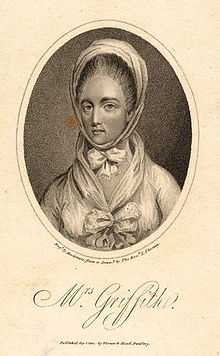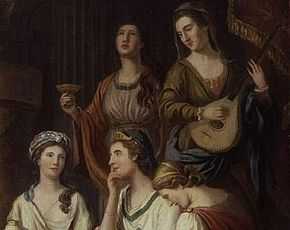Elizabeth Griffith


Elizabeth Griffith (née Griffith) (1727 – 5 January 1793), sometimes also credited Elizabeth Griffiths,[1] was an 18th-century Irish dramatist, fiction writer, essayist and actress, best known for her edition of Shakespeare's comedies published in 1775.
Biography
Griffith was born in Glamorgan, Wales to Dublin theatre manager Thomas Griffith and Jane Foxcroft Griffith sometime in the 1720s, though more recent scholarship suggests she was born in 1727. Very little about Griffith's early life is known. Her father, who had doted on her, died in 1744. The family was rocked by sudden financial insecurity and the seventeen-year-old Griffith began seeking means to earn her own keep, likely taking small provincial acting jobs. She certainly eventually became a professional actress; her theatrical debut occurred on 13 October 1749, and in her two-year career on the stage she played such roles as Juliet in Romeo and Juliet, Cordelia in King Lear, Sylvia in The Double Gallant, and Ismene in Phaedra and Hippolitus, among others. Though she was not formally educated beyond what was considered appropriate for her gender (with some guidance in polite literature and social graces), her acting career gave her exposure to many different writers and allowed her a kind of makeshift literary education.
In 1751, Griffith was married in secret to Richard Griffith (no relation). Richard's parents did not approve of the match, as they had wished their son to marry a wealthy woman, and Richard attempted to take Griffith as his mistress. She refused, holding out for marriage. After the clandestine wedding, Griffith left the theatre (though there are reports that she took on minor roles in later years for purposes of income), and gave birth to two children, Catherine and Richard. Her husband travelled once the couple had married, and was absent for extended periods. The marriage was rumoured to have been deeply troubled, with Richard taking a mistress for a period during the marriage; Griffith's increasing celebrity was also cause for conflict and separations between the two, as Richard's own career floundered. He had borrowed a large sum of money to develop a linen business, which went bankrupt in 1756. During this time, and while Richard was avoiding debtor's court, income generated by Griffith's writing sustained the family, and eventually she opted to move alone to London (leaving the children in the care of her mother) to earn more money producing her plays.
Griffith's son worked for the East India Company as an accountant, and eventually returned to Ireland in 1786. He settled at Millicent House in Kildare, and Griffith and her husband lived out the rest of their days at this residence. Griffith died at Millicent House in 1793.
Bibliography
Griffith wrote a number of comedic plays, five of which were performed. These plays are: The Platonic Wife (1765), The Double Mistake (1766, though some scholarship questions her authorship of this text), The School for Rakes (1769, an adaption of Beaumarchais's Eugénie), A Wife in the Right (1772, also known as Patience the Best Remedy), and The Times (1779). Of these plays, The School for Rakes was by far her most popular text.
She also published two extremely well loved non-fiction texts. The Morality of Shakespeare's Drama Illustrated (1775) was a collection of Shakespeare's comedies with Griffith's own commentaries about the morality of the plays. This work is significant as it is one of the earliest attempts at literary criticism by a woman. Essays, Addressed to Young Married Women (1782), published posthumously in the United States as Letters Addressed to Young Married Women (1796), was a very successful collection of prose that collected Griffith's thoughts on child rearing, wifely duty, and financial balance.
Griffith earned money for her family through translation work, translating from French into English. Her work included predominantly memoirs and collections of letters by people like Ninon de L'Enclos, Marthe–Marguerite, Marquise de Caylus, and even Voltaire. She also translated some French novels, such as The Princess of Cleves: An Historical Novel by Marie-Madeline, comtesse de La Fayette
Fiction was also a well-known mode to Griffith, who published a number of novels in her lifetime. The Delicate Distress (1769) was published alongside a work of her husband's, a novel titled The Gordon Knot (1769), in a four volume set. Her format of choice for her fiction was the epistolary novel, as in both The History of Lady Barton (1771) and The Story of Lady Juliana Harley (1776). She also published one dramatic poem, Amana (1764).
Themes and connections
Though Griffith's first plays were deeply critical of the treatment of women, her work underwent a shift soon after her move to London. Griffith found herself attacked by London critics, and she was seen as audacious for demanding respect for women. Where other female playwrights of the time, such as Aphra Behn, were able to work through such criticism, Griffith was not. The need to earn money to support her husband and children led her to conform to contemporary sexual stereotypes; she could not afford to challenge expected norms if it meant losing audiences and pounds.
After this shift, Griffith's main focus became the domestic sphere. It was at this point that she abandoned the intelligent female protagonist and began to create meek, long-suffering and deeply pained female characters who bear the brunt of a traumatic life with a ne’er-do-well (and often violent) husband. From here her work became quite moralistic; for example, The Times is a warning against the dangers of gambling. But, though she had to package it differently in order to retain an audience, she never fully lost her focus on women's issues, and her female characters are always the moral superiors of their male counterparts. Overall, her texts focus on a need for moral development – literature as didactic – and she tends to use her female characters as the barometer of moral correctness.
Griffith did not see herself as alone in this moral quest. She edited a collection of female dramatists such as Eliza Haywood and Aphra Behn. Though these women's plays were at the time linked to sexual immorality, Griffith argued instead that these women were instructional dramatists who were trying to teach the world about proper morality. This was likely the first reassessing of Behn's work particularly, but that of women writers in general, and illustrates the important premium Griffith placed upon proper morality.
Contemporary reception
In her own lifetime, Griffith was probably best regarded for the letters between her and her husband that were published over six volumes. A Series of Genuine Letters between Henry and Frances (1757–1770) was a celebrated series that featured the edited letters of Mr. and Mrs. Griffith as they moved through courtship to marriage. In the letters, genuine sentimentality is the mode of discourse, and women seem to have been drawn to Griffith as a model of womanhood, illustrating sought-after traits such as intelligence, reflection, and humour. Frances Burney was a fan of this collection, and she referred to the letters as an encouragement for her own style of heartfelt writing.
Her plays seem to have received mixed reviews. The Dictionary of Literary Biography states that reviewers of productions of Griffith's work occasionally complained "about poor plotting or lack of incident," but that overall audiences were engaged by Griffith's "admirable" sentiments and morals (175). Though audiences occasionally complained that her female characters were too heavily foregrounded, Griffith's women were always serious characters with well-developed personal values. Griffith was seen as a moralist in much of her work, and was sometimes accused of being unseemly for her use of satire, as it was not considered feminine.
Griffith chose to publish some plays by subscription, and subscribers to her work included Gertrude Russell, Edmund Burke, James Boswell, Elizabeth Montagu, and Sir Joshua Reynolds.
Recent research
According to the Dictionary of Literary Biography, modern historians of drama have generally considered Griffith's plays "undistinguished, often dramatically inept and tediously sententious" (175). Modern readers often feel uncomfortable with the conflicting relationship between women's ability and wifely duty and the general tone of subordination to men encompassed within the play.
Though there remains very little scholarly work on Griffith's life and literature, her body of work represents both an interesting life and an illustration of the struggles of an ordinary woman of modest means attempting to make a career for herself in the 18th century. While not as well-known to modern times as her contemporaries (like Susanna Centlivre), she was certainly a prolific writer in her own period and had made her name in the literary world by the time of her death.
External links
- Millicent House, Kildare, Ireland
- Elizabeth Eger, ‘Griffith, Elizabeth (1727–1793)’, Oxford Dictionary of National Biography, Oxford University Press, 2004, accessed 11 Nov 2006
References
| Wikisource has the text of the 1885–1900 Dictionary of National Biography's article about Griffith, Elizabeth. |
- "Elizabeth Griffith." English Drama, 1660–1800: A Guide to Information Sources. Frederick M. Link, ed. Detroit: Gale Research, 1976. 199.
- Finberg, Melinda C. Eighteenth-Century Women Dramatists. Oxford: Oxford University Press, 2001.
- Griffith, Elizabeth. Letters Addressed to Young Married Women. Philadelphia: Turner, 1796.
- Griffith, Elizabeth. The Delicate Distress. Cynthia Booth Ricciardi and Susan Staves, ed. Lexington, KY: University Press of Kentucky,1997.
- Staves, Susan. "Elizabeth Griffith." Dictionary of Literary Biography: Restoration and Eighteenth Century Dramatists, Third Series. Detroit: Gale Research, 1989.
- Author and Bookinfo.com